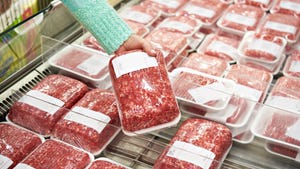Wal-Mart Raises the Food Safety Bar
June 2, 2010

E. coli “season” is upon us; it rolls around each summer when shedding spikes for unknown scientific reasons. Many are hoping there won’t be a corresponding spike in positives in meat samples and resulting recalls, as seen the past two years.
Food safety and demand are the beef industry’s biggest issues. The two are strongly linked, as the 1993 Jack-in-the-Box E. coli O157:H7 tragedy showed.
Beef recalls in the following decade cost the industry $1.6 billion in lost demand, according to Kansas State University agricultural economist Ted Schroeder. An even larger amount was likely lost in the past seven years due to E. coli recalls and concerns about BSE.
The loss in demand is the biggest financial cost to the industry. But other costs have arguably impacted the industry more. The Jack-in-the-Box tragedy set off a series of regulatory and other actions that cost beef packers and further processors huge amounts of money.
These included the introduction of hazard analysis critical control points (HACCP) regulations for all plants. Such additional food safety costs have been the main reason for packer consolidation since the early 1990s. And, as beef end users continue to require more food safety assurances from their suppliers, there will be even more consolidation.
The added costs have been extensive. The top 10 packers from 1993 to 2003 spent $400 million introducing pathogen-intervention systems in their plants; and another $250 million in increased operating costs. Added spending by the next 20 packers was $100 million. Recall costs in the decade added another $100 million to packers’ costs. That’s $850 million in just a decade. These numbers come from a special study of the cost of E. coli that I conducted in late 2002. BSE since 2004 has cost beef packers an additional $100 million/year in removal of additional specified risk materials.
Not included in my E. coli analysis was the cost – either on live-cattle prices or on local communities – of plant closures. My research reveals that at least 18 fed-cattle plants and 23 cow-slaughter plants closed from 1995 to 2009; that’s 37,700 head of daily slaughter capacity. Then there are the closures of dozens of small further-processing plants. Food safety costs were a common factor.
That’s why an announcement last month by Wal-Mart Stores, the largest beef seller in the U.S., is so important. The giant retailer says it will implement additional safety measures to further protect its customers against foodborne illnesses.
The measures will require its beef suppliers to implement validated food safety interventions that result in reductions in E. coli O157:H7, other E. coli strains and salmonella. Beef slaughter suppliers will have to implement interventions that eventually result in a 5-log reduction in pathogens. Processing suppliers must implement interventions that result in a 2-log reduction.
Many of Wal-Mart’s beef suppliers already do what Wal-Mart is asking. But a few smaller suppliers will likely have to improve their food safety interventions and/or their validation processes. Wal-Mart’s action will raise the food safety bar for everyone who buys and sells beef in the U.S. There will likely be similar measures quietly introduced by other major retailers that won’t want to be seen as having food safety standards inferior to Wal-Mart’s.
On top of this move are legislative and other efforts to expand food safety requirements that appear laudable in intent but would add costs. For example, Sen. Kirsten Gillibrand (D-NY) wants six additional strains of E. coli, known as non-O157 STECs, to be included as hazardous adulterants. These would require testing by packers and USDA.
These developments will continue to impact the viability of small beef processors. So the industry will likely see another round of plant closures. That’s the real cost of food safety.
Steve Kay is editor and publisher of Cattle Buyers Weekly (www.cattle
buyersweekly.com).
About the Author(s)
You May Also Like





